OpenCV 中有两种特征匹配方法:暴力匹配 (Brute force matching) 和 最近邻匹配 (Nearest Neighbors matching)
它们都继承自 DescriptorMatcher,是基于特征描述符距离的匹配,根据描述符的不同,距离可以是 欧氏距离,也可以是 汉明距
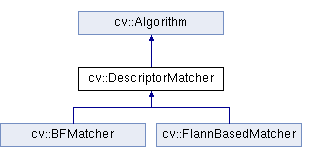
1 暴力匹配
首先,任取图像 A 的一个特征描述符,计算它到图像 B 中所有特征描述符的距离;然后,将所得到的距离进行排序;最后,选择距离最短的特征,作为 A-B 的匹配点
1.1 BFMatcher
BFMatcher 属于 features2d 模块,继承自 DescriptorMatcher,其 create() 函数如下:
1 2 3 4 | static Ptr<BFMatcher> create( int normType = NORM_L2, // normType, One of NORM_L1, NORM_L2, NORM_HAMMING, NORM_HAMMING2. bool crossCheck = false // crossCheck); |
1) normType 距离类型
SIFT和SURF 的 HOG 描述符,对应欧氏距离 L1 和 L2;ORB 和 BRISK 的 BRIEF 描述符,对应汉明距 HAMMING;HAMMING2 则对应当 WTA_K = 3或4 时的 ORB 算法
- 欧氏距离:最常用的一种距离定义,指的是 n 维空间中,两点之间的实际距离
- 汉明距离:计算机的异或操作,适用于二进制串描述符,如 BRIEF 描述符,定义如下:
2) crossCheck 交叉核对
- 如果在图像 B 中,特征 是特征 的最佳匹配,并且在图像 A 中,特征 也是特征 的最佳匹配,则称 为 "good match"
1.2 代码示例
特征匹配步骤如下:读图 -> 提取特征 -> 计算特征描述符 -> 暴力匹配 -> 显示匹配结果
1 2 3 4 5 6 7 8 9 10 11 12 13 14 15 16 17 18 19 20 21 22 23 24 25 26 27 28 29 30 31 32 | #include "opencv2/highgui.hpp"#include "opencv2/features2d.hpp"using namespace cv;int main(){ // 1) read Mat img1 = imread("box.png", IMREAD_GRAYSCALE); Mat img2 = imread("box_in_scene.png", IMREAD_GRAYSCALE); if (img1.empty() || img2.empty()) return -1; // 2) detect and compute Ptr<SIFT> sift = SIFT::create(); std::vector<KeyPoint> kps1, kps2; Mat desc1, desc2; sift->detectAndCompute(img1, Mat(), kps1, desc1); sift->detectAndCompute(img2, Mat(), kps2, desc2); // 3) match Ptr<BFMatcher> bfmatcher = BFMatcher::create(NORM_L2, true); std::vector<DMatch> matches; bfmatcher->match(desc1, desc2, matches); // 4) draw and show Mat img_matches; drawMatches(img1, kps1, img2, kps2, matches, img_matches); imshow("BFMatcher", img_matches); waitKey();} |
crosscheck 分别为 true 和 false:
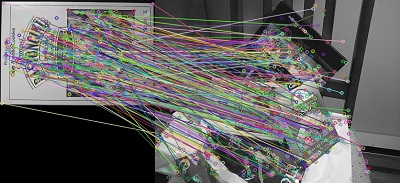
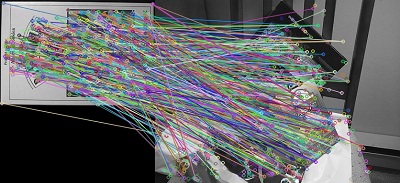
2 最近邻匹配
FLANN 是一个开源库,全称 Fast Library for Approximate Nearest Neighbors,它实现了一系列高维向量的近似最近邻搜索算法
基于 FLANN 库的最近邻匹配算子 FlannBasedMatcher,在特征数据集较大或一些实时处理领域,其运行效率要远高于 BFMatcher
OpenCV 中 FlannBasedMatcher 的定义如下:
1 2 3 4 5 6 7 8 9 | // This matcher trains cv::flann::Index on a train descriptor collection and calls its nearest search methods to find the best matches. // So, this matcher may be faster when matching a large train collection than the brute force matcher. class FlannBasedMatcher : public DescriptorMatcher{public: FlannBasedMatcher( const Ptr<flann::IndexParams>& indexParams=makePtr<flann::KDTreeIndexParams>(), const Ptr<flann::SearchParams>& searchParams=makePtr<flann::SearchParams>() ); static Ptr<FlannBasedMatcher> create(); |
2.1 距离比
为了进一步提高特征匹配精度,David Lowe 提出了一种最近邻次近邻距离比的方法:
- 取图像 A 的一个特征,搜索它到图像 B 距离最近的两个特征,距离分别记为 和 ,只有当 小于某个阈值时,才认为是 "good match"
"good match" 的概率密度函数 PDF (Probability Density Function) 与最近邻次近邻距离比的关系,如下:
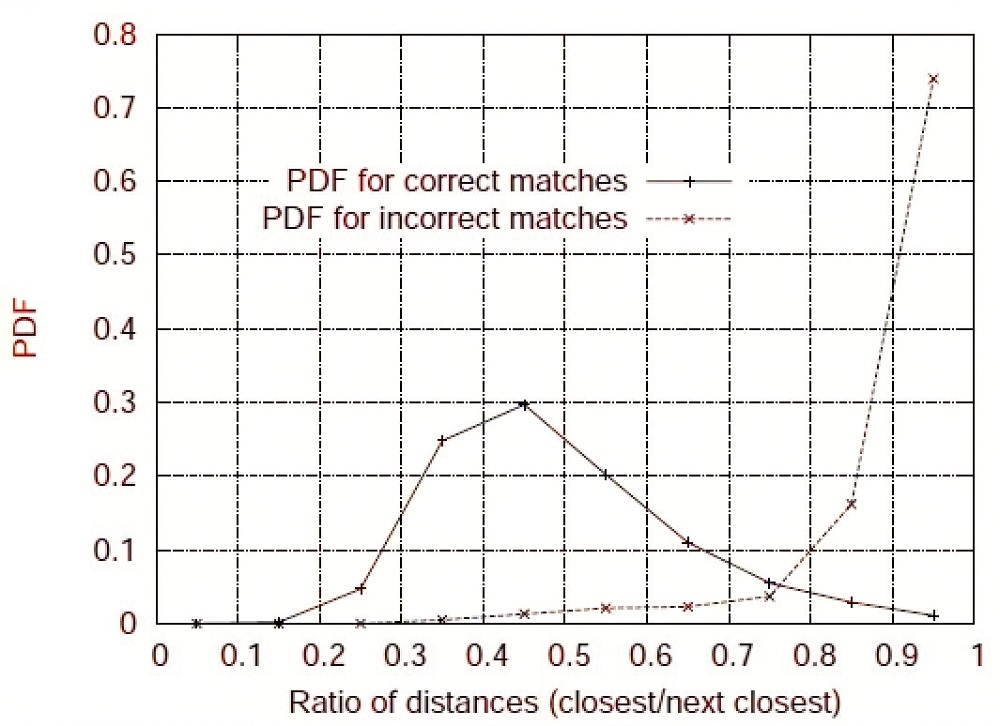
2.2 代码示例
取 distance ratio = 0.7,对比使用和不使用距离比滤波的匹配效果,代码如下:
1 2 3 4 5 6 7 8 9 10 11 12 13 14 15 16 17 18 19 20 21 22 23 24 25 26 27 28 29 30 31 32 33 34 35 36 37 38 39 40 41 42 43 | #include "opencv2/highgui.hpp"#include "opencv2/features2d.hpp"using namespace cv;const float kRatioThresh = 0.7f;int main(){ // 1) read Mat img1 = imread("box.png", IMREAD_GRAYSCALE); Mat img2 = imread("box_in_scene.png", IMREAD_GRAYSCALE); if (img1.empty() || img2.empty()) return -1; // 2) detect feature and compute descriptor Ptr<SIFT> sift = SIFT::create(); std::vector<KeyPoint> kps1, kps2; Mat desc1, desc2; sift->detectAndCompute(img1, Mat(), kps1, desc1); sift->detectAndCompute(img2, Mat(), kps2, desc2); // 3) FLANN based matcher Ptr<FlannBasedMatcher> knnmatcher = FlannBasedMatcher::create(); std::vector<std::vector<DMatch> > matches; knnmatcher->knnMatch(desc1, desc2, matches, 2); // 4) filter matches using Lowe's distance ratio test std::vector<DMatch> good_matches; for (size_t i = 0; i < matches.size(); i++) { if (matches[i][0].distance < kRatioThresh*matches[i][1].distance) { good_matches.push_back(matches[i][0]); } } // 5) draw and show matches Mat img_matches; drawMatches(img1, kps1, img2, kps2, good_matches, img_matches); imshow("Good Matches", img_matches); waitKey();} |
匹配效果对比如下:
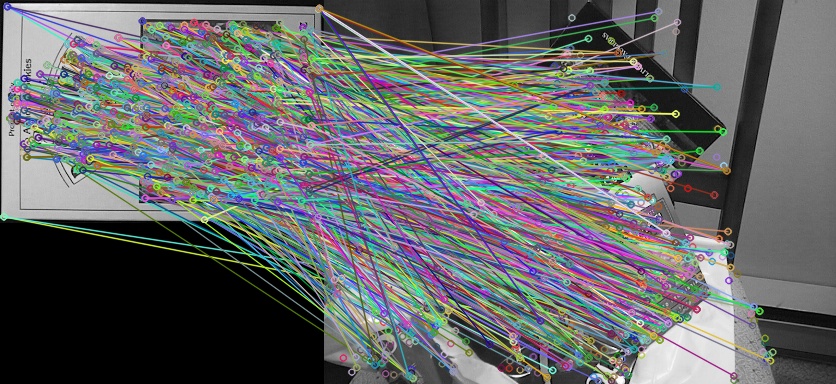

3 应用示例
特征匹配 + 平面单应性,在计算机视觉中有很多应用,如:透视校正,目标定位等
3.1 透视校正
OpenCV 之 平面单应性 4.1 中的示例,并不是标准的透视校正,因为是人拿着标定板旋转不同角度,使相机和标定板产生了相对的视角变换,而不是相机和整个场景之间
多视图几何中,严格意思的透视校正,是指相机在不同的视角下,对同一场景成不同的像而进行的视角校正,如下图:

在得到匹配点对 good_matches 之后,再执行如下代码,便可用于透视校正
1 2 3 4 5 6 7 8 9 10 11 12 13 14 15 16 17 18 | // Localize the objectstd::vector<Point2f> obj, scene;for (size_t i = 0; i < good_matches.size(); i++){ // Get the keypoints from the good matches obj.push_back(kps1[good_matches[i].queryIdx].pt); scene.push_back(kps2[good_matches[i].trainIdx].pt);}// estimate HMat H = findHomography(scene, obj, RANSAC);// warp scene Mat scene_warp;warpPerspective(img2, scene_warp, H, Size(1.35*img2.cols, img2.rows)); // showimshow("scene_warp", scene_warp); |
校正前后的结果如下:


3.2 目标定位
得到匹配点对 good_matches 后,再执行如下代码,便可用于目标定位
1 2 3 4 5 6 7 8 9 10 11 12 13 14 15 16 17 18 19 20 21 22 23 24 25 26 27 28 29 30 | // Localize the object std::vector<Point2f> obj; std::vector<Point2f> scene; for (size_t i = 0; i < good_matches.size(); i++) { // Get the keypoints from the good matches obj.push_back(kps1[good_matches[i].queryIdx].pt); scene.push_back(kps2[good_matches[i].trainIdx].pt); } // estimate H Mat H = findHomography(obj,scene, RANSAC); // get the corners from the image_1 ( the object to be "detected" ) std::vector<Point2f> obj_corners(4); obj_corners[0] = Point2f(0, 0); obj_corners[1] = Point2f((float)img1.cols, 0); obj_corners[2] = Point2f((float)img1.cols, (float)img1.rows); obj_corners[3] = Point2f(0, (float)img1.rows); std::vector<Point2f> scene_corners(4); perspectiveTransform(obj_corners, scene_corners, H); // draw lines between the corners (the mapped object in the scene - image_2 ) line(img_matches, scene_corners[0] + Point2f((float)img1.cols, 0), scene_corners[1] + Point2f((float)img1.cols, 0), Scalar(0,255,0)); line(img_matches, scene_corners[1] + Point2f((float)img1.cols, 0), scene_corners[2] + Point2f((float)img1.cols, 0), Scalar(0,255,0)); line(img_matches, scene_corners[2] + Point2f((float)img1.cols, 0), scene_corners[3] + Point2f((float)img1.cols, 0), Scalar(0,255,0)); line(img_matches, scene_corners[3] + Point2f((float)img1.cols, 0), scene_corners[0] + Point2f((float)img1.cols, 0), Scalar(0,255,0)); // show detected matches imshow("Object detection", img_matches); |
目标定位结果如下:

参考资料
OpenCV-Python Tutorials / Feature Detection and Description / Feature Matching
OpenCV Tutorials / 2D Features framework (feature2d module) / Feature Matching with FLANN
OpenCV Tutorials / 2D Features framework (feature2d module) / Features2D + Homography to find a known object
原文链接: http://www.cnblogs.com/xinxue/
专注于机器视觉、OpenCV、C++ 编程




【推荐】国内首个AI IDE,深度理解中文开发场景,立即下载体验Trae
【推荐】编程新体验,更懂你的AI,立即体验豆包MarsCode编程助手
【推荐】抖音旗下AI助手豆包,你的智能百科全书,全免费不限次数
【推荐】轻量又高性能的 SSH 工具 IShell:AI 加持,快人一步
· AI与.NET技术实操系列:向量存储与相似性搜索在 .NET 中的实现
· 基于Microsoft.Extensions.AI核心库实现RAG应用
· Linux系列:如何用heaptrack跟踪.NET程序的非托管内存泄露
· 开发者必知的日志记录最佳实践
· SQL Server 2025 AI相关能力初探
· winform 绘制太阳,地球,月球 运作规律
· 震惊!C++程序真的从main开始吗?99%的程序员都答错了
· AI与.NET技术实操系列(五):向量存储与相似性搜索在 .NET 中的实现
· 【硬核科普】Trae如何「偷看」你的代码?零基础破解AI编程运行原理
· 超详细:普通电脑也行Windows部署deepseek R1训练数据并当服务器共享给他人